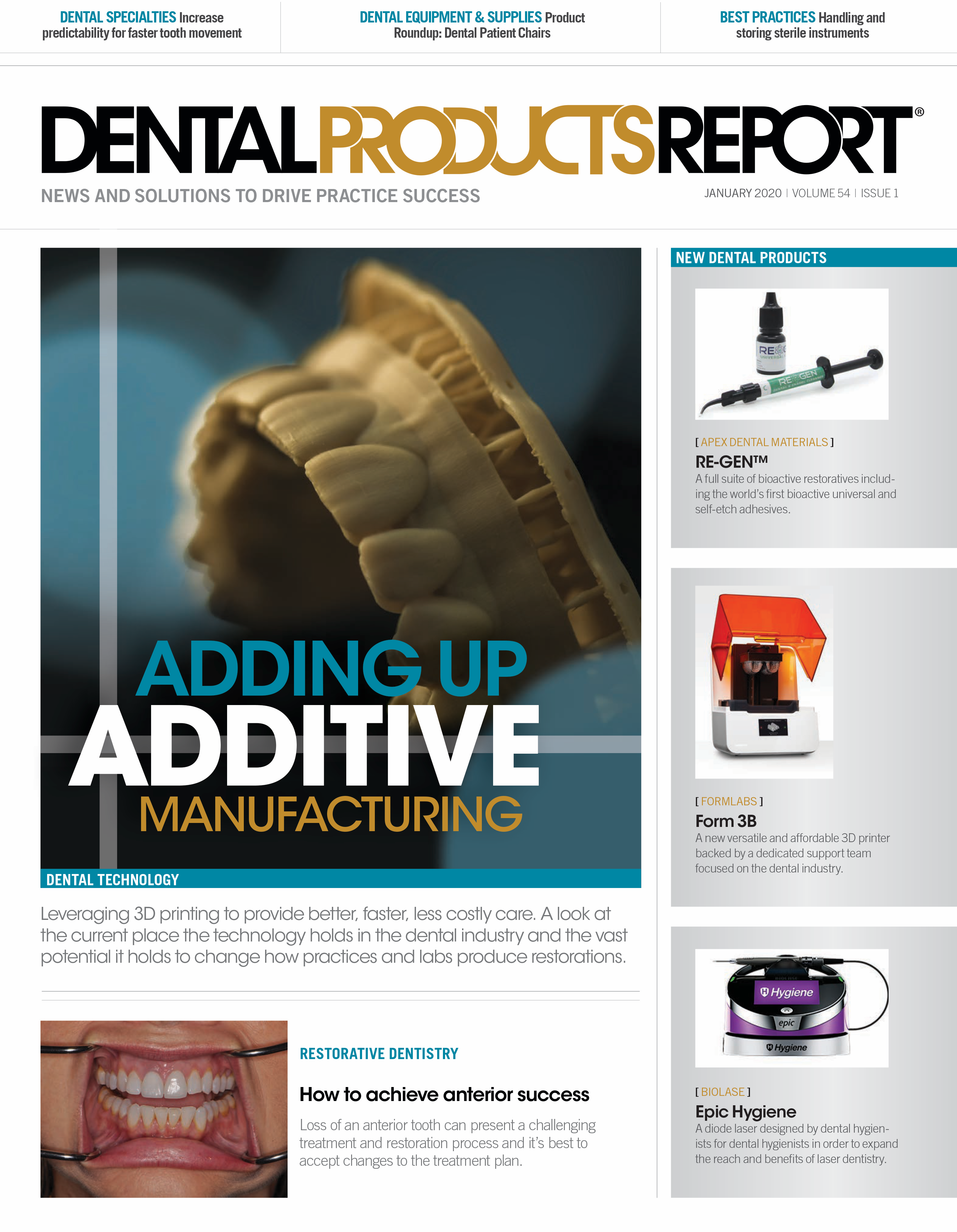Adding up Additive Manufacturing
Leveraging 3D printing to provide better, faster, less costly care.
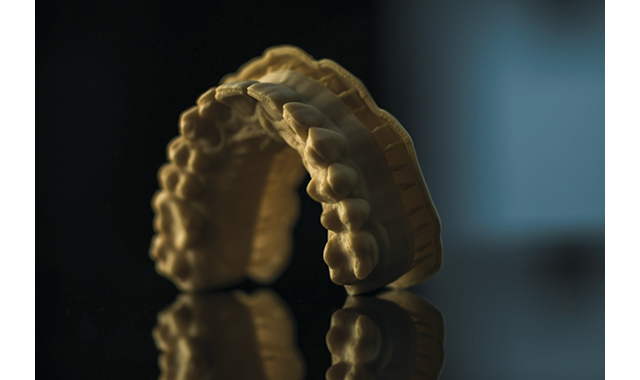
In his 19th century novella, Flatland: A Romance of Many Dimensions, author Edwin A. Abbott chronicles a two-dimensional world inhabited by polygons of various, numbered sides. Ultimately, the protagonist-a square, aptly named “A Square”-is visited by a sphere, a denizen of the three-dimensional world known as Spaceland. Because A Square lives in a two-dimensional realm, he only perceives the sphere as points appearing on that plane-meaning, it manifests itself as circles of various sizes.
In many ways, dentists are just as amazed by the outcomes of 3D printing as A Square was by his discovery of a third dimension. For those who have only ever printed something on the flat, two-dimensional surface of a sheet of paper, the ability to print three-dimensional objects may seem somewhat astonishing as A Square’s interaction with the sphere.
3D printing has become a revolutionary means for production across all sorts of industries, and dental is incorporating it, as well. Dental laboratories initially embraced the technology, but now, dentists, themselves, are able to add those printers to their CAD/CAM workflows, offering patients a number of items quickly, more efficiently, and at less cost.
Beyond the lab
There was a time when 3D printing was the sole purview of the dental laboratory. But times have changed, and now, more and more practices are adopting the technology for in-house use.
A finished build of 10 Keystone Keysplint Clear nightguards on the build platform in a Carbon M2 3D printer. This nightguard print job took 1 hour, 39 minutes to print and allows nightguard fabrication without the need for a model.

P. Christian Rose is the director of dental channels and sales, North America, at EnvisionTEC. EnvisionTEC is a manufacturer of dental 3D printers and materials. In 2008, they collaborated with Glidewell Dental Lab to first bring 3D printing to the dental industry. Since then, EnvisionTEC has provided equipment and materials to laboratories and clinicians in a wide range of dental and orthodontic applications.
“The dental industry is moving digital,” Rose says. “Doctors and labs are taking those digital scans, and it allows them to very rapidly produce a variety of parts. For the patient, there’s that immediacy of delivery, control of quality, a large cost savings, as well as savings of time.”
Continue reading on the next page...
3D printing has become a pervasive part of everyday life and it is a natural fit for dentistry.
“When we look at 3D printing with a wide lens, we see that the technology is very accessible today, even by consumers for making toys and trinkets at home,” says Jamie Stover, CDT, senior manager of dental lab applications at Carbon, a company that offers hardware, software, and materials for 3D printing and connects clients’ printing efforts to the cloud to monitor performance and adjust as needed.
“But when we focus that lens on the unique requirements of our industry and on the demands that the oral health care profession as a whole places on providers for products and materials that are safe for patient use; highly accurate, to ensure that restorations fit with precision; are durable, so that restorations hold up in the oral environment; and that can be produced quickly and at a cost that allows labs and clinicians to operate more efficiently and profitable, it becomes crystal clear that not all printers are created equal and there isn’t one tool for every job. Using 3D printing to fabricate dental restorations requires a robust printer that can produce highly accurate products with speed and consistency," Stover adds.
"Dental is a natural fit for 3D printing. I believe, in the next 10 years, all dental appliances, restorations, and everything else will get the majority share of being 3D printed directly…the portfolio is just going to expand.”
-Sam Wainwright
For the clinician, 3D printing is a burgeoning technology-and an opportunity.
Rik Jacobs is the vice president and general manager of 3D Systems, focusing on dental 3D printing. 3D Systems offers printers and materials for prosthodontics, orthodontics, implantology, and dentures.
“We are just at the starting point, as far as the dental office is concerned,” Jacobs says. “It started being massively adopted by the labs in 2016-2017. And what’s very important in this part of the business is the adoption of the intraoral scanner and then the size of a dental office. Dental offices are offering more and more treatments under the same roof, so they have multiple chairs, they have different kinds of specialized doctors-implantology, prosthodontics, orthodontics. They also have people in-house who can, for instance, design and who can give either mill or print services.”
Clinical advantages
3D printing allows for efficiencies to traditional processes, streamlining patient visits.
Ken Haldeman is the executive director of business initiatives for Zahn Dental, which offers 3D printing solutions, including its FirstFit Guided Prosthetics Delivery System. FirstFit allows clinicians to print trays allowing the placement of three-unit bridges and up to 10 upper and lower veneers, all at once.
A finished build of 6 Dentsply Lucitone Print denture bases on the build platform in a Carbon M2 3D printer. 6-8 denture bases take a little over 2 hours to print and the system uses special Dentsply carded teeth for an FDA approved result with high impact strength and premium denture esthetics.
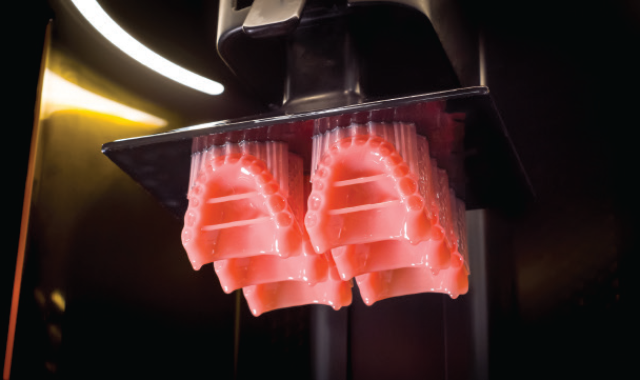
“In a traditional process, the clinician would diagnose restorative needs on first visit; complete preparation, take traditional and/or intraoral scans and place temporary restorations on second visit; remove the temporaries, complete cleanup and then place restorations on third visit; thus the use of the most advanced digital technology within FirstFit combined with 3D printing makes restorative and cosmetic dentistry more efficient, convenient and predictable for both the dentist and patient, alike,” Haldeman says.
“You have increased speed and accuracy with printing, as opposed to other reductive technologies,” says Beth Collington, director of digital materials and laboratory equipment at Zahn Dental. “You just can get a much more accurate final restoration on so many levels with so many different types of materials. With the cost of the printers being so economical these days, you can literally purchase a printer at any price point, depending on build space, speed, and accuracy. Especially now, with the smaller footprints for a dental office, it makes sense to add it to the workflow.”
3D printing seems to be making great inroads into all sorts of industries, and it is a good match for dental.
Dávid Lakatos is Formlabs’s chief product officer and says that his company’s objective was to create a 3D printer targeted to the dental industry that wouldn’t break the bank.
Continue reading on the next page...
“We’ve always thought that the real market was in creating a printer that doesn’t cost hundreds of thousands or millions of dollars and can print the same quality as the large industrial machines,” he says. “In 2011, that was nowhere to be found. So we created that category, a $3,500 printer that performs better than the large industrial machines.”
The result was a Kickstarter campaign that raised $3 million towards its development.
Formlabs Form 3B printer with printed products and CAM software.

Formlabs recently launched a new dental business unit, Formlabs Dental, with a new Form 3B printer and new materials specific to the dental industry.
“Dental is a natural fit for 3D printing,” says Sam Wainwright, the dental product manager at Formlabs. “I believe, in the next 10 years, all dental appliances, restorations, and everything else will get the majority share of being 3D printed directly. We see that today happening a little bit, but that portfolio is just going to expand more and more. So, right now, for the dental practice specifically, direct-printed appliances, like surgical guides, splints, those sorts of things, make a ton of sense for practices.”
The resins used in 3D printers are as important as the printers, themselves.
Chris Niquette, president of EvoDent Digital, describes his company’s printers as “selectively open,” meaning they can use resins from other companies, but they have to be properly validated, first.
“We don’t just allow them to put any resin in there,” Niquette says. “As they come out with new and innovative products, we’re able to get them validated in our machine fairly quickly. They send us the product for the resin testing and validation. So it’s done in the proper way, especially if it’s going to be something that’s a biocompatible and has to be FDA-cleared.”
It’s just so exciting to think about the fact that you could have somebody walk into your office on Monday morning…and by Tuesday morning, you could have the entire case designed, printed, and ready to go. That’s a big deal.” -Dr. John Flucke
But not all 3D printers are created equally, especially when one considers the unique demands of medical devices.
Planmeca offers its Creo C5, a chairside 3D printer, allowing the fabrication of customized surgical guides, dental models and aligner bases in a single patient visit.
“There are a lot of different 3D printers on the market,” says Jukka Kanerva, vice president of Planmeca’s Dental Care Units and CAD/CAM Group. “And, mainly, they are developed for general industry purposes-prototyping or whatever different type of applications, different industries are using. But we have focused on having a printer only for dental and supporting the whole clinical workflow, and to make the printer as user-friendly as possible. We have been able to develop it so that it’s simple to use, and supports the clinical workflow and doesn’t require any additional technical set-up at the clinical site.”
Continue reading on the next page...
Additive technologies (such as 3D printing) fundamentally differ from reductive technologies (such as milling), because rather than carve something from a block of material, they build it, a layer at a time. The chief benefit is it is more efficient.
The FirstFit Veneer system from EnvisionTEC allows the placement of up to 10 upper and lower veneers at one time.
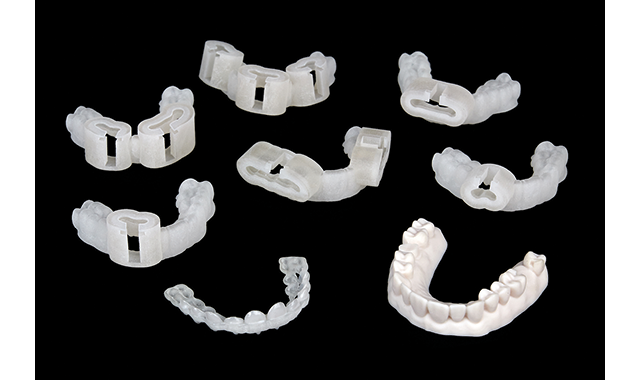
“Reductive technology is inherently wasteful, because we are taking a large piece of material, cutting out only the pieces we need, and the rest is unused and thrown out,” Stover observes. “Additive production processes allow labs and dentists to create products from finite amounts of resin. And, speaking about the Carbon Digital Manufacturing Platform specifically, when you upload designed files to our CAM software, the software calculates the precise amount of resin you need for that print job and those restorations.
You’re not guessing and pouring an undetermined amount of resin in the printer, printing the parts, and losing the rest in a purge cycle when you change materials. Our system allows super-fast change-over between builds and most all of the unused resin to be captured, stored, and reused quickly and easily, meaning production is much more efficient and cost-effective for all products.”
Products
There are a number of products that dentists can 3D print, ranging from models to surgical guides to nightguards. As new materials become available, look for even more items to be 3D printable.
“Number one would be surgical guides for implants,” Dr. John Flucke, DDS, Technology Editor for Dental Products Report, says. “That has become such a big deal in the industry of doing guided surgery. It used to be, they sit down at their computer and designed these cases on the computer and then they send all of that data to a lab somewhere, and then the lab makes the surgical guide. It’s just so exciting to think about the fact that you could have somebody walk into your office on Monday morning, you could gather the data, both physically and electronically, do your cone beam scan and maybe do a 3D impression scan, and by Tuesday morning you could have the entire case designed, printed and ready to go. That turnaround, now, is probably a week, maybe more. And that’s a big deal. You can also do bruxism guards, orthodontic retainers.”
Continue reading on the next page...
“You can print models very, very easily-regular, standard models for crown and bridge or for orthodontic,” Collington adds. “For 3D dentures, manufacturers have created materials to print the denture base and the teeth at different levels of quality. There are also surgical guide materials available. You can print nightguards and bite splints. There are castable materials of all different viscosities. And then, of course, you have your temporary materials for various applications. All of this is available in multiple, different shades.”
3D printing is also useful for quickly producing even complex items.
“One example is the 3D-printed dentures that are being produced now,” Stover says. “A traditional packed acrylic denture requires an experienced denture technician to spend hours of hands-on time to fabricate, very much like fabricating ceramic crowns by hand once did before we had options like zirconia and glass ceramics that can be digitally produced. The Dentsply/Carbon partnership for the Lucitone Print denture is the first time in history that a high-impact denture, which is also highly esthetic, and FDA-cleared for patient use, can be produced on a 3D printer, an indication of what 3D printing offers our industry today and foreshadowing the solutions that it will continue to provide as new materials are developed.”
3D-printed items do not have to be, directly, usable by the patient. They can be components of a larger workflow.
“There’s many other uses, even indirectly,” Wainwright says. “So, say, if a practice has an intraoral scanner and they just need a quick diagnostic model used for patient presentation or case planning, that’s very attractive-as opposed to having to send that file out to a lab, have it printed, pay the bill from the lab. This is going to be something that the doctor can have in his hands very quickly and very cost-positive.”
"There have been two major roadblocks which have prevented widespread adoption; a lack of materials for viable applications, and unreliable printers that were unable to produce highly accurate parts consistently.”
-Jamie Stover, CDT
Those models can be a stepping stone to other products, such as the base for clear aligners, Kanerva says, adding that Planmeca’s Dental Care unit will soon introduce more materials for orthodontic splints as well as the individual trays and indirect bonding trays.
For everything that 3D printing offers, the one thing not yet achievable are the final restorations-the crowns, Haldeman says.
“The final restoration still, at this moment in time, remains with the dental laboratory, outside of like a CEREC chairside application. When it comes to 3D printing, we’re not seeing a lot of the final restorations, yet, at the dental office,” he says.
At this point, the industry does not have permanent restorations, at least not yet, Rose adds. But that could change as early as next year.
“We have long-term temporaries, and this tech is currently up to seven shades. After the first of the year, we will have a new denture base and a new tooth material coming out that will give us increased hardness for both the denture base and the teeth, as well as five different shades of the denture base and seven different shades and the teeth. But also we’re working out the ability to layer and have gradual shading rather than the teeth just being monolithic.”
The 3D-printed files are stored digitally, which means that they are easily and efficiently reproducible. This provides a customer service opportunity to the clinician. If a patient loses his or her appliance, doctors are able to provide the service to replace it free of charge-it’s still a moneymaker and is good for patient relations.
“By offering that additional warranty on the product, because it’s only going to cost the dentist maybe $5 or $6 in material, just pull up the file and reprint it, and then the patient can come pick it up,” Niquette says.
Continue reading on the next page...
Obstacles
If 3D printing is so great, why isn’t it every dental office? Reasons range from the complexity of adding the workflow to something as simple as just not wanting to do the work.
“Price is one thing,” Kanerva says. “But I think the bigger thing is that the mainstream of 3D printers are designed for general industry and for specialists and engineers and those types of users. That ease of using the 3D printing and understanding 3D printing, I think that has been a big, big hurdle. That’s why we wanted to create our printer as easy as possible, so you don’t need to play around with different parameters, and so forth.”
3D printing is not an easy implementation into a daily workflow, Jacobs observes. Practices must obtain a scanning device, have the software to design a surgical guide, an implant case or a denture, and the clinician and support staff must learn each step of the complete workflow, he says. While this kind of new technology probably isn’t being taught in dental schools just yet, Jacobs predicts it will be more universal when the next generation begins to study dentistry because they want everything digital and as predictable as possible.
Formlabs Form 3B printer with printed products and CAM software.
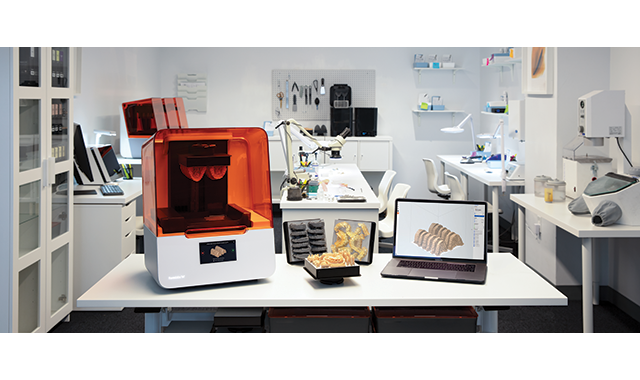
Generally speaking, many dentists are set in their ways. Once they find a certain path, they tend to stick with it. Because 3D printing is a technology that is new enough that some dentists may simply be wary of adopting it. But the industry could be seeing a change to that attitude, Rose says.
“There’s an acceptance level,” he says. “How does it work? How well does it work? We all become creatures of habit, and we have to be willing to change our daily workflow, how we do things. Three, four years ago, I was at a dental trade show, and there was maybe one or two other [3D printer manufacturers] there besides us. And a lot of the conversation of attendees was, ‘What is 3D printing? How does it work? How well does it work?’ The last time I counted, there were 29 different printers for sale in the dental industry. And that’s just the desktop printers. So, acceptance is increasing, dramatically.”
The learning curve involved and complementary equipment needed to create items on a 3D printer is another barrier to clinicians, Wainwright notes. As 3D printing is one cog in a complete digital workflow, the transition into 3D can seem daunting, not to mention expensive, too many clinicians, he adds.
Continue reading on the next page...
“And that is a huge barrier because if you’re not doing production like a laboratory, it might not justify the reasons for getting into one of those expensive, purpose-built dental CAD softwares,” Wainwright says. “For surgical guides, you need an intraoral scanner, but you also need a CBCT scanner. So, you need to be able to have the bone density scans to go along with the impression. And so those are pretty expensive pieces of equipment, but the prices are coming down.”
Resellers, too, will have a vital role in educating dentists and using the equipment. It’s important to partner with a dental laboratory for case design and optimal final outcome.
The ability to print numerous parts at once allows optimal efficiency and speed.
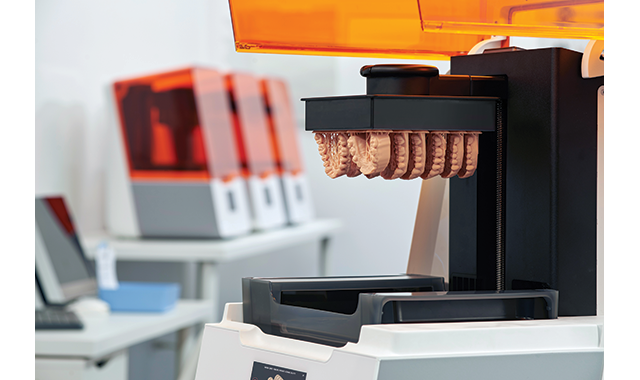
“Is the reseller capable of giving all the training, service and support for transitioning from analog to digital, without any hesitations or problems or learning curves or startup issues?” Jacobs ponders. “Or, is everybody still happy sticking to the old ways? We need more advocates who are sharing their excellent use or experiences.”
Another factor is that dentists simply like being dentists, Jacobs notes. This could be characterized as an unwillingness to work outside a patients’ mouth if possible, meaning the dentist doesn’t have ample time to design, print, and process a 3D print job.
“So, they need to evaluate, if it is a one-man or two-man enterprise, or is it the medium or large office under one roof, that is available to do the design and print and post-cure integrated being implemented into a perfect workflow?”
While dentists are able to create a number of items with their 3D printers, the Holy Grail-permanent restorations-is still elusive, so clinicians may be waiting on that capability.
“You can do certain things with 3D printers that are amazing, but the biggest holdback, I think, is that we do not yet have the ability to print permanent restorations,” Dr. Flucke observes. “I think that it’s early enough in the curve that mainstream people are still looking at it and thinking, ‘You know, do I want to get involved in this?’"
For some clinicians, it isn’t the right time to buy into 3D printing because the technology might not be ready, Collington adds. However, within the last year, there has been an increase in accuracy levels, she says.
Continue reading on the next page...
“That’s been a true game-changer. Where you’re starting to see a lot more implementation in laboratories and doctors’ offices, because of this technology companies have brought the price point down and increased the size of build platforms, resulting in more space to print restorations and higher accuracy than ever before.”
Stover observes that appropriate materials-or lack, thereof-can be a hurdle, as can be unreliable printers, themselves. Those two components have to work reliably, especially when patients’ needs are concerned.
“There have been two major roadblocks, historically, which have prevented widespread adoption; a lack of materials for viable applications, and unreliable printers that were unable to produce highly accurate parts consistently,” Stover says. “More recently, we have seen an increase in accuracy and reliability for some printers, and there have been more resins developed for dental applications hitting the market.
"When a lab or clinician transitions from analog production methods to digital, they shift the entire workload, and the technicians, to the digital production processes," Stover continues. "When printers are unable to produce products with the required accuracy, are slow, and take a long time to produce parts-and break down during a build-it is devastating to the production and workflow and instills a lack of confidence. These are a couple factors that have hindered widespread adoption and have also created a ‘once bitten, twice shy’ mentality for 3D printer users who have experienced these disruptions to their workflow in the past.”
Continue reading on the next page...
Costs
As with anything, cost is an important factor in a technology’s acceptance. But, is price an obstacle to the adoption of 3D printing? The answer is a resounding: It depends.
“I guess it depends on what you consider ‘reasonably affordable’,” Niquette says. “Let’s say a dentist picks a $15,000 or $16,000 printer price point. If they finance it, and it may be a $350-a-month payment. If the dentist does one nightguard in a month, they have more than paid for a payment on a printer. But, it just depends on where you are. We’ve actually transitioned over and we’re offering a lease on the machine. We did that, specifically, because we had a lot of doctors wondering, ‘Hey, if I buy that, three years from now, what’s coming next?’
"And it’s a good point, because three years from now, there’ll probably be new players in the market, there’ll be new models," Niquette continues. "We’ll certainly have next-generation machines. So, by doing a lease, the dentist can basically use the equipment and then, say, 36 months from now, they can replace it with the most current version of our product. Or maybe there’s another one they’ve seen out there that they want to go with.”
But paying for the machine is only one cost consideration, Jacobs says. Other related costs include post-curing equipment, scanning, software, and training, he mentions.
“So, in total, we’re talking about $10,000 for the printer. But if you need to buy a scanner and the software and the whole package, so that’s around $30,000. So, let’s say you have three-year depreciation periods. It’s $10,000 per year. That’s around $800-900 per month.”
cDLM (Continuous Digital Light Manufacturing) Technology from EnvisionTEC, peeds up the DLP process by adding a thin layer of oxygen between the layer being cured and the material tray. This layer of oxygen inhibits the resin from curing, which in turn adds many exciting properties. This technology provides speed and accuracy.

However, the upfront costs could save money down the road, Jacobs says.
“Well, when you talk about a denture and you print the base and you print the teeth and you combine the two parts, then you can save 90 percent of the cost of implementing 3D printing into your daily workflow, compared to the analog ways. So you only have to make two dentures per month. But that’s only dentures. You can print surgical guides for implant operations, and the materials cost only $3. It’s very economic and we see a lot of doctors in the U.S. buying the system. Economically, it’s an excellent model. It’s predictable and it’s a secure, constant, quality output.”
But it isn’t as straightforward as stating, “3D printing costs $15,000” for instance. There are a number of factors that go into calculating the true cost of bringing 3D printing services in-house, Stover says.
“The price of a printer is subjective because the return on investment is calculated many ways,” he says. “ROI is determined by calculating the cost to produce a restoration on a given piece of hardware; the overall operational costs, which are in part determined by the number of parts you are able to produce in a given unit of time; the material costs; the cost of labor for operators; how reliable the printer is; and the number of applications and products you can produce with it that are currently costing much more with traditional fabrication methods, to name just a few,” Stover says.
Continue reading on the next page...
“At Carbon, we use cost modeling and deep-dive into each individual business to calculate the true cost savings of printing. If a 3D printer’s price is within reach for dentists, it actually means, ‘Does it make financial sense for a dentist to invest in a 3D printer for their business to produce restorations in-office?’" Stover continues. "That determination has to be done on a case-by-case basis and depends on the overall volume of cases/restorations and other factors I listed.”
With new technologies, sometimes it’s hard for practices to decide when is the right time to pull the trigger and spend the money on a new technology. Much of this hesitation can be attributed to the idea that such new technology is very expensive, says Dr. Flucke.
“Something will be on the market for 10 years, and then dentists will say, ‘Well, when are they going to get cheaper?’” he says. “It’s like cars. We’ve been making cars for a hundred years, but are they going to get cheaper than when Henry Ford made them? But the thing is that 3D printers are not very expensive, really. You can get a really nice one for way under $10,000.”
The cost of the technology is negligible, Collington adds, because it is so affordable.
“You see more group practices adopting this,” she says. “It really comes down to where are they making the most return on their investment? Do they take their time to design a unit, which is going to be the most time-consuming piece of it, or are they just hiring and working with a service to do that? I think you’re going to see more adoption. It’s very easy to use this right now.”
“We’ve seen doctors and we’ve seen practices engage at the $100,000-plus level for lesser technologies,” Haldeman observes. “I think a lot of it is concern of volatility. The concern is, ‘Am I going to buy something today that’s going to be obsolete in six months or a year?’”
Whether the practice buys the equipment now or waits longer, an important component is realizing that they get what they pay for.
“You don’t get the same results with a printer at a lower price point that you would get with a printer at a higher price point,” Collington observes. “So the expectations really need to be set.”
Materials
3D printing and its capabilities are not just dependent on the machines-the materials used to create items are a necessary component. The current batch of materials are certainly appropriate and get the job done, but there’s always room for improvement, and the future holds more for potential applications. Manufacturers recognize this and are anticipating the needs of the dental industry.
“Obviously, the needs of a dentist are different than the needs of an engineer,” Lakatos says. “The connective tissue is materials. Every single new material formulation is going to open up a new application, which opens up a new industry. That’s exactly how we got into dentistry, as well. So, the way we think about it is that biocompatible material development is a very core part of our dental strategy.
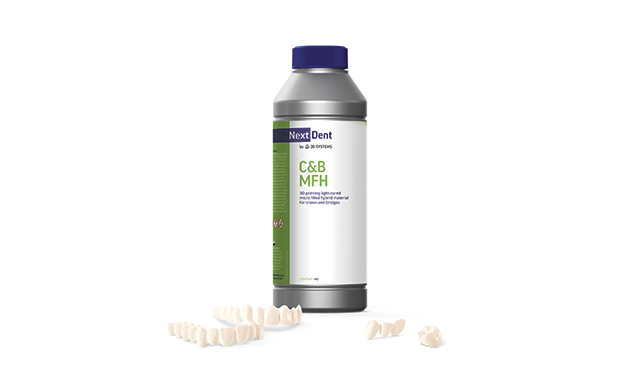
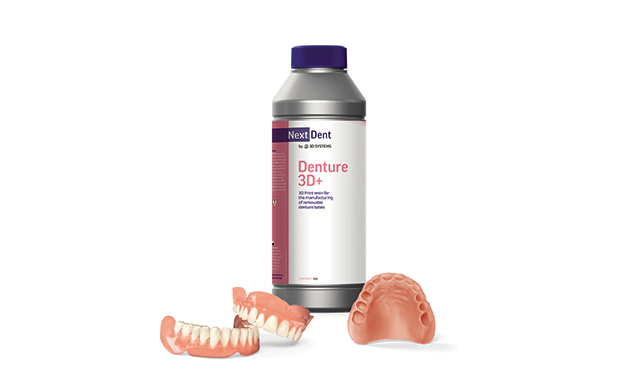
NextDent offers various resins for 3D printing applications, including longterm temporaries and denture bases.
“We actually bought a chemical company in Ohio and are manufacturing our materials, 100 percent from scratch,” Lakatos continues. “And, while materials are good enough to get the current jobs done, they are in a constant state of advancement.”
Materials are constantly evolving, says Jacobs, who adds that 3D Systems is currently working on printing a long-term composite crown.
Continue reading on the next page...
“And then, what could be interesting in the long-run for doctors, is to print direct metal implant abutments. Ultimately, one day in the future, I’m 1,000 percent sure that it will be possible to print direct clear aligners, for instance,” Jacobs says.
Advancements in materials are coming in leaps and bounds, Collington says. Such progress is even happening every few months, she adds.
“You’re seeing incredible leaps and bounds in materials today,” Collington says. “It’s amazing what they’ve done as far as improvement of esthetics and functionality. The first generation of dentures, for example, were printed on more of an economy-type of denture, but you’re seeing improvements now in just overall esthetics, where you’re starting to see layered teeth. So, you get a much more beautiful, natural-looking final restoration. You’re seeing increased strength in physical properties. Your megapascal strength for impact is much higher.”
But, as good as materials are now, there are always a variety of upgrades being made, Rose observes.
“Like any technology, it’s never completed,” he says. “The beauty of 3D printing, especially with EnvisionTEC, is that everything starts with a liquid resin, and the machines don’t become antiquated or out-of-date. As new softwares and new resins are developed, it’s just the next piece of the puzzle that you can add to that machine.”
The future
The future of 3D printing in the industry will occur on two fronts-dentists and manufacturers. For clinicians, an important part is going to be understanding how to use it.
“A huge component of this is about how we teach our users through either written reports or internally developed applications, guides, and videos to enable a more efficient use or better use of our products,” Wainwright says.
“And then something that I’m very excited about is a support team that’s focused and specialized in dental. I think that’s going to really increase the accessibility component of this because there’s going to be a team dedicated to our customers and users being successful.”
Education is the key to changing doctors’ acceptance of buying into 3D printing technology and integrating them into the practice, Niquette says.
The dental industry is moving digital. Doctors and labs are taking those digital scans…For the patient, there’s that immediacy of delivery, control of quality, a large cost savings, as well as savings of time.”
-P. Christian Rose
“Right now, you and I can go out and sign up for courses at every major trade show for CAD/CAM training. Right now, we can have the best product in the world, but if there isn’t education on a much bigger scale, that’s what slows any technology’s acceptance down. Look how long intraoral sensors took to get it to get accepted in the marketplace and how long it took dentists to get away from film.”
On the manufacturer front, look for printers to be able to handle larger workloads at higher speeds, Rose says.
“We’re going to see continued increase in size of build platforms as well as speed,” Rose says. “We always want to, first, put maintaining how accurate the part is when it’s completed. It is as, if not more important than the size of the build area or how fast we do it. The sky’s the limit with 3D printing.”
The types of products available are also expected to broaden. While there will always be a market for companies such as Invisalign and ClearCorrect, Dr. Flucke anticipates more doctors will be interested in eliminating the middleman and printing these products themselves.
The missing link to all of this is permanent restorations, which aren’t too far off, Kanerva says.
“We would like to see more biocompatible materials, also implantable materials. Also, more development in the whole process of printing, itself. It will be more and more user-friendly and easier for the users,” he says.
Ultimately, even though 3D printing is somewhat of a nascent technology-especially in the dental world-everyone seems to agree it is the future.
“If you look at the world today and the current methods of manufacturing, it’s pretty clear that additive production and 3D printers are going to completely revolutionize the way products are manufactured, and age-old manufacturing dilemmas are solved,” Stover says. “This transformation is happening daily. It is like a new Industrial Revolution, and there’s honestly never been a more exciting time to be working in the dental industry, and I believe that in less time than some may think, 3D printing will become the primary method of digital manufacturing in our industry and in every other industry.”
A Square’s world and perception of the universe was changed when sphere entered Flatland. Dentists today are facing a similar paradigm shift, but once they embrace it, they can certainly achieve faster, easier, more efficient workflows, that have the potential to save them money.
